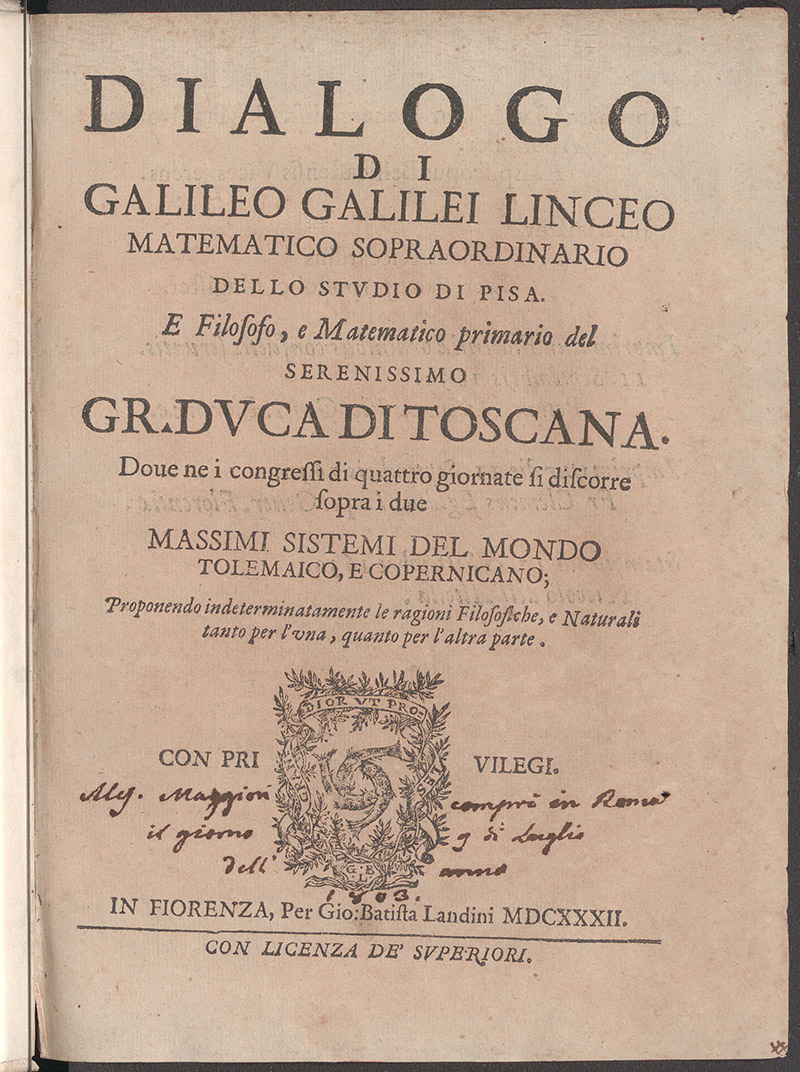Dialogo

- Title page.
- Galileo Galilei (1564-1642).
- Dialogo di Galileo Galilei Linceo matematico sopraordinario dello studio di Pisa. E filosofo, e matematico primario del Serenissimo Gr. Duca di Toscana. Dove ne i congressi di quattro giornate si discorre sopra i due massimi sistemi del mondo Tolemaico, e Copernicano.
- Florence: Giovanni Batista Landini, 1632.
In 1633 Galileo published a discussion in the form of a Platonic dialogue on the two chief world systems, Ptolemaic and Copernican, a treatise designed to show the superiority of the Copernican system over the cosmologies of Aristotle and Ptolemy, whose teachings had been endorsed by the Church for centuries. The book is presented as a series of dialogues between two philosophers and one layman in the course of four days. Salviati defends the Copernican position on the motion of the earth; Simplicio is devoted to Aristotle and Ptolemy; and Sagredo is a layman mostly acting as an inquisitive moderator between the two opposing sides.
The publication of the Dialogo is the culmination of Galileo’s long-planned project to publish a definitive defense of the Copernican system. In 1616, Galileo wrote the Discorso sul flusso e il reflusso del mare (Discourse on the Tides), an essay written in the form of a letter to his patron Cardinal Alessandro Orsini. In this work, Galileo defended the Copernican system by explaining the motion of the tides as the result of the Earth’s rotation and revolution around the Sun. However, Galileo had to cancel its publication: on orders of Pope Paul V, Cardinal Bellarmine summoned Galileo to his residence, warning him against the ideas of the Copernican system. Shortly afterward, the Church suspended Copernicus’ De Revolutionibus until corrected. But the publication of Il Saggiatore in 1624, endorsed by Pope Urban VIII, encouraged Galileo to compose a long letter in response to Cardinal Francesco Ingoli’s tract of 1616, De situ et quiete Terrae contra Copernici systema disputatio (Disputation on the Location and Immobility of the Earth, against the Copernican System). Finally, in 1629, Galileo began the revision of the Discorso sul flusso e il reflusso del mare, to which he added many of the arguments he had used against Cardinal Ingoli. Since Galileo’s theory of tides presupposed the motion of the earth, he was advised to change the title of the work, to eliminate any references to the tides, before its publication in 1632. Amazingly, Pope Urban VIII immediately prohibited the Dialogo, appointing a special commission to examine the book. Based on the commission’s report, Urban VIII referred the case to the Inquisition, which summoned Galileo to Rome in 1633. After being interrogated, and under the threat of torture, Galileo abjured his “errors” in a formal ceremony at the Church of Santa Maria Minerva. Despite his decantation, Galileo was condemned by Urban VIII to indefinite imprisonment, being allowed to spend the rest of his days at this residence in Arcetri, near Florence.
Our copy bears an ownership inscription at the bottom of the page: “Ales.[ssandro] Maggiori comprò in Roma il giorno 9 di lougio dell’anno 1803.” (Alessandro Maggiori bought it in Rome on 9 July 1803). Plausibly, this book was part of the extensive library of Alessandro Magiori (1764-1834), the famous Italian art critic and collector of old master drawings.
Select Bibliography
- Feldhay, Rivkha. 1995. Galileo and the Church: Political Inquisition or Critical Dialogue? Cambridge and New York: Cambridge University Press.
- Galilei, Galileo. 1967. Dialogue Concerning the Two Chief World Systems: Ptolemaic & Copernican. Trans. Stillman Drake. Foreword by Albert Einstein. Berkeley, Cal.:University of California Press.
- Koyré, Alexandre. 1939. Études Galiléennes. Paris: Hermann.
- Marcus, Hannah and Paula Findlen. 2019. “Deciphering Galileo: Communication and Secrecy before and after the Trial.” Renaissance Quarterly 72 (3): 953-995.
- Wilding, Nick. 2014. Galileo’s Idol: Gianfrancesco Sagredo and the Politics of Knowledge. Chicago: University of Chicago Press.